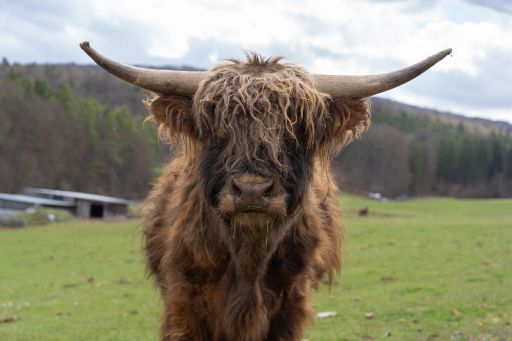Introduction
Highland cows, a Scottish breed with long horns and a shaggy coat, originated in the Scottish Highlands and Western Islands. Known as gentle giants, they thrive in harsh climates and produce high-quality meat with 40% less fat and cholesterol.
Where can I see Highland cow in Scotland?
Highland cows, a Scottish breed of rustic cattle, are known for their thick, shaggy coats, enabling them to survive harsh temperatures. They can be found in various locations throughout Scotland.

What is the average lifespan of a
Highland cow?
Highland cows have an average lifespan of 18 years, with some living up to 20-25 years. They are known for their better milk production and more meat on their bones, making them a longer-lived breed compared to most other breeds.

Are they easy to take care of Highland Cow?
Highland cows, low-maintenance animals, thrive in harsh conditions in the Highlands and Islands. They are ideal for conservation grazing due to their ability to graze on rough vegetation. Their long shaggy coats protect them from the elements, but they require access to fresh water and quality grazing land. However, proper nutrition and veterinary care are crucial for their well-being.
More about Scottish wildlife.
Scotland is a popular destination for wildlife enthusiasts, known for its diverse natural history and diverse wildlife. The Scottish Wildlife Trust is dedicated to protecting and restoring Scotland’s wildlife, with projects focusing on osprey breeding sites and preserving native red squirrels. However, many species face threats due to human actions, and the Scottish Wildlife Trust website provides information on key threats and solutions. The fauna of Scotland is typical of the northwest European part of the Palearctic realm.
What are some other cattle breeds in Scotland?
Scotland is home to several cattle breeds, each with its own unique characteristics. Here are some of the cattle breeds found in Scotland:
- Aberdeen Angus: Known for their black color and high-quality beef, Aberdeen Angus cattle are one of the most popular breeds in Scotland.
- Ayrshire: A medium-sized breed known for its adaptability and milk production1.
- Belted Galloway: These cattle have a distinctive white belt around their midsection and are known for their hardiness and lean beef2.
- Galloway: Galloway cattle are known for their adaptability to harsh climates and their ability to thrive on rough grazing land3.
- Highland: Highland cows are famous for their long shaggy coats and long horns. They are well-adapted to the tough climate of the Highlands and Islands2.
- Luing: Luing cattle are a crossbreed between Highland and Shorthorn cattle. They are known for their hardiness and ability to produce high-quality beef1.
- Shetland: Shetland cattle are a small breed native to the Shetland Islands. They are well-suited to grazing on rough terrain1.
- Whitebred Shorthorn: Whitebred Shorthorn cattle are known for their white coat color and their ability to thrive in upland areas.
These are just a few examples of the diverse range of cattle breeds found in Scotland. Each breed has its own unique characteristics and contributes to Scotland’s rich agricultural heritage.

Highland beef, a premium breed of Scottish cattle, is known for its high quality meat, with 40% less fat and cholesterol than normal beef. This healthful and nutritious beef is naturally tender and delicious, with a distinctive flavor. Ultrasound tests on Highland bulls reveal rib eye areas, good marbling, and little outside back fat, resulting in a lean, well-marbled flesh. Highland cattle are often raised primarily for their meat, providing numerous health benefits over other grass-fed breeds.
Disadvantages of Highland cattle.
Highland cattle have several advantages, but they also have some disadvantages. Here are a few of them:
- Wellbeing & health: Although Highland cattle are known for their excellent genetics to fight against disease, they aren’t entirely infallible. Some bloodlines can have health issues and temperament differences. Overgrown hooves can be an issue, especially in Australian breeds. Ticks and lice can find a home in their thick layering, especially in hot weather1.
- Management & temperament: Highland cattle have had a long lineage of living freely on open mountains, so they aren’t too fond of being cooped up in confined spaces. They thrive on a more diverse diet and wild habitat. Their temperament is generally docile and cooperative, but they need a consistent, friendly human touch to keep them on friendly terms. They are cunning creatures and can break out of enclosures due to their thick hair acting as an insulator to electric fences1.
- Low milk production: Highland cows were the lifeblood of small rural communities in Scotland, but their milk production is relatively low compared to other breeds1.
Please note that these disadvantages don’t diminish the overall value of Highland cattle, but they are important considerations when raising them.

